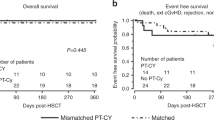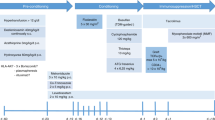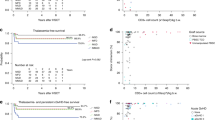Abstract
Mixed chimerism (MC) occurs frequently after allogeneic hematopoietic stem cell transplantation (HSCT) for thalassemia major (TM) and may be associated with rejection. We report the outcome of MC in 132 TM patients conditioned with Busulphan/Cyclophosphamide, who had successful engraftment and had ⩾1 year follow-up. Chimerism was first assessed at day +28, then every 3–9 months or more frequently if there was MC. If rejection was suspected, immunosuppression was stopped and donor-lymphocyte infusion (DLI) was given if there was no response. Among 132 patients, aged 7 years (range: 2–24), 46/132 (34.8%) had MC in the first year, 32/46 (69.6%) at day +28 and another 14 (30%) between day +28 and 1 year post HSCT. MC was quantified at level 1 (residual host chimerism (RHC) <10%) in 20 (43.5%), level II (RHC 10–25%) in 14 (30.4%) and level III (RHC >25%) in 12 (26.1%). On tapering immunosuppression, 15 (32.6%) developed acute GvHD and 8 (17.4%) had chronic GvHD with reversal to complete chimerism (CC). DLI was administered to 5/46 (10.9%), 1 evolved to CC but 4 rejected the graft. At median follow-up of 60 months (range: 16–172), 20/46 (43.5%) had CC, 18/46 (39.1%) had persistent MC with hemoglobin of 11.5 g/dL (range: 8.4–13.6), whereas 8 (17.4%) rejected the graft. Close monitoring and early intervention is needed with increasing recipient chimerism. Novel strategies are required for preventing graft rejection.
This is a preview of subscription content, access via your institution
Access options


Similar content being viewed by others
References
Andreani M, Testi M, Gaziev J, Condello R, Bontadini A, Tazzari PL et al. Quantitatively different red cell/nucleated cell chimerism in patients with long-term, persistent hematopoietic mixed chimerism after bone marrow transplantation for thalassemia major or sickle cell disease. Haematologica 2011; 96: 128–133.
Andreani M, Testi M, Lucarelli G . Mixed chimerism in haemoglobinopathies: from risk of graft rejection to immune tolerance: persistent mixed chimerism and immune tolerance. Tissue Antigens 2014; 83: 137–146.
Angelucci E, Baronciani D . Allogeneic stem cell transplantation for thalassemia major. Haematologica 2008; 93: 1780–1784.
Hsieh MM, Wu CJ, Tisdale JF . In mixed hematopoietic chimerism, the donor red cells win. Haematologica 2011; 96: 13–15.
Hsieh MM, Wu CJ, Tisdale JF . In mixed hematopoietic chimerism, the donor red cells win. Haematologica 2011; 96: 13–15.
Andreani M, Manna M, Lucarelli G, Tonucci P, Agostinelli F, Ripalti M et al. Persistence of mixed chimerism in patients transplanted for the treatment of thalassemia. Blood 1996; 87: 3494–3499.
Andreani M, Testi M, Battarra M, Lucarelli G . Split chimerism between nucleated and red blood cells after bone marrow transplantation for haemoglobinopathies. Chimerism 2011; 2: 21–22.
Andreani M, Testi M, Battarra M, Indigeno P, Guagnano A, Polchi P et al. Relationship between mixed chimerism and rejection after bone marrow transplantation in thalassaemia. Blood Transfus 2008; 6: 143–149.
Amrolia PJ, Vulliamy T, Vassiliou G, Lawson S, Bryon J, Kaeda J et al. Analysis of chimaerism in thalassaemic children undergoing stem cell transplantation. Br J Haematol 2001; 114: 219–225.
Lucarelli G, Clift RA, Galimberti M, Polchi P, Angelucci E, Baronciani D et al. Marrow transplantation for patients with thalassemia: results in class 3 patients. Blood 1996; 87: 2082–2088.
Chandy M, Balasubramanian P, Ramachandran SV, Mathews V, George B, Dennison D et al. Randomized trial of two different conditioning regimens for bone marrow transplantation in thalassemia–the role of busulfan pharmacokinetics in determining outcome. Bone Marrow Transplant 2005; 36: 839–845.
Mathews V, George B, Viswabandya A, Abraham A, Ahmed R, Ganapule A et alImproved clinical outcomes of high risk β thalassemia major patients undergoing a HLA matched related allogeneic stem cell transplant with a treosulfan based conditioning regimen and peripheral blood stem cell grafts.PLoS ONE 2013 8 e61637.
Sellathamby S, Balasubramanian P, Sivalingam S, Shaji RV, Mathews V, George B et al. Developing an algorithm of informative markers for evaluation of chimerism after allogeneic bone marrow transplantation. Bone Marrow Transplant 2006; 37: 751–755.
Alizadeh M, Bernard M, Danic B, Dauriac C, Birebent B, Lapart C et al. Quantitative assessment of hematopoietic chimerism after bone marrow transplantation by real-time quantitative polymerase chain reaction. Blood 2002; 99: 4618.
Andreani M, Nesci S, Lucarelli G, Tonucci P, Rapa S, Angelucci E et al. Long-term survival of ex-thalassemic patients with persistent mixed chimerism after bone marrow transplantation. Bone Marrow Transplant 2000; 25: 401–404.
Balasubramanian P, Desire S, Sugumaran P, ML K, Abraham A, Viswabandya A et al. Trough level of first dose of busulfan (Cmin1) is a stronger predictor of graft rejection than steady state concentration (Css1) in patients with beta thalassemia major undergoing allogeneic hematopoietic stem cell transplantation. Blood 2015; 116: 518.
Balasubramanian P, Desire S, Panetta JC, Lakshmi KM, Mohanan E, Viswabandya A et al. Pharmacokinetics of cyclophosphamide metabolites influence outcome in patients with β-thalassemia major undergoing allogeneic HSCT. Blood 2015; 118: 1941.
Anurathapan U, Hongeng S, Pakakasama S, Sirachainan N, Songdej D, Chuansumrit A et al. Hematopoietic stem cell transplantation for homozygous β-thalassemia and β-thalassemia/hemoglobin E patients from haploidentical donors. Bone Marrow Transplant 2016; 51: 813–818.
Anurathapan U, Pakakasama S, Mekjaruskul P, Sirachainan N, Songdej D, Chuansumrit A et al. Outcomes of thalassemia patients undergoing hematopoietic stem cell transplantation by using a standard myeloablative versus a novel reduced-toxicity conditioning regimen according to a new risk stratification. Biol Blood Marrow Transplant 2014; 20: 2066–2071.
Andreani M, Gianolini ME, Testi M, Battarra M, Tiziana G, Morrone A et al. Mixed chimerism evolution is associated with T regulatory type 1 (Tr1) cells in a β-thalassemic patient after haploidentical haematopoietic stem cell transplantation. Chimerism 2014; 5: 75–79.
Breuer S, Preuner S, Fritsch G, Daxberger H, Koenig M, Poetschger U et al. Early recipient chimerism testing in the T-and NK-cell lineages for risk assessment of graft rejection in pediatric patients undergoing allogeneic stem cell transplantation. Leukemia 2012; 26: 509–519.
Rajasekar R, Mathews V, Lakshmi KM, George B, Viswabandya A, Chandy M et al. cellular immune reconstitution and its impact on clinical outcome in children with β thalassemia major undergoing a matched related myeloablative allogeneic bone marrow transplant. Biol Blood Marrow Transplant 2009; 15: 597–609.
Author information
Authors and Affiliations
Corresponding author
Ethics declarations
Competing interests
The authors declare no conflict of interest.
Rights and permissions
About this article
Cite this article
Fouzia, N., Edison, E., Lakshmi, K. et al. Long-term outcome of mixed chimerism after stem cell transplantation for thalassemia major conditioned with busulfan and cyclophosphamide. Bone Marrow Transplant 53, 169–174 (2018). https://doi.org/10.1038/bmt.2017.231
Received:
Revised:
Accepted:
Published:
Issue Date:
DOI: https://doi.org/10.1038/bmt.2017.231
This article is cited by
-
Is Old (Fludrabine/Busulfan/Cyclophosphamide/rAntiThymocyteGlobulin) Conditioning Still Gold for Allogeneic Transplants in Transfusion Dependent Beta-Thalassemia of All Risk Categories in 21st Century?
Indian Journal of Hematology and Blood Transfusion (2023)
-
Recent results of hematopoietic stem cell transplantation for thalassemia with busulfan-based conditioning regimen in France: improved thalassemia free survival despite frequent mixed chimerism. A retrospective study from the Francophone Society of Stem Cell Transplantation and Cellular Therapy (SFGM-TC)
Bone Marrow Transplantation (2023)
-
Survival and late effects of hematopoietic cell transplantation in patients with thalassemia major
Bone Marrow Transplantation (2022)
-
Unresolved issues in allogeneic hematopoietic cell transplantation for non-malignant diseases
International Journal of Hematology (2022)
-
Unmanipulated Stem Cell Boost for Mixed Chimerism in Transfusion Dependent Thalassemia
Indian Journal of Hematology and Blood Transfusion (2021)



